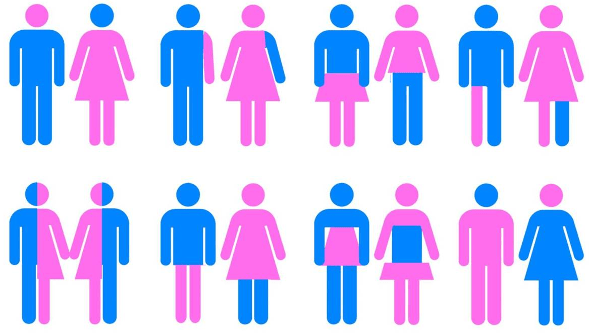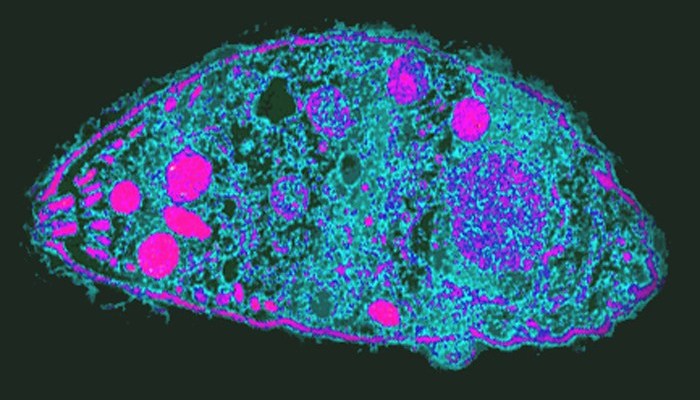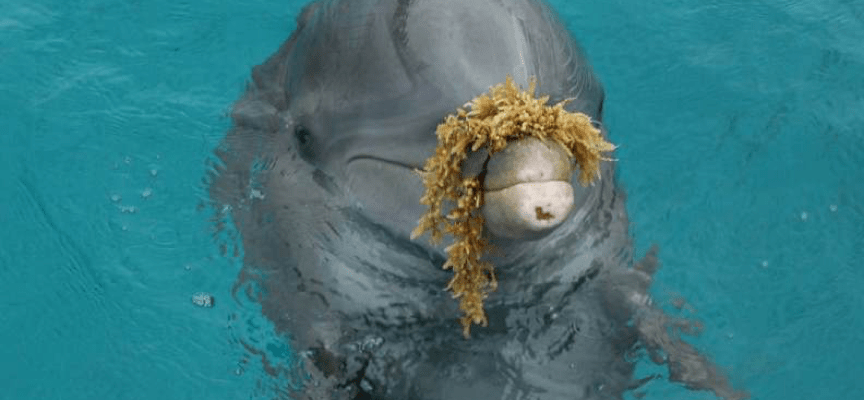|
By Julia Zeh
Edited by Bryce Harlan Our oceans cover over 70% of the Earth’s surface. Everyone has heard this at some point in their lives, whether they learned it in school or read it somewhere. But sometimes, I think we forget how vast and expansive 70% of the Earth’s surface really is. Even more amazing is the fact that we’ve explored less than 5% of it. That leaves a humongous portion of the Earth unexplored and unknown. We know more about the Moon, which is about 238,900 miles away from us, than we do about the oceans that, for some of us, are right next door. These facts become more incredible as we begin to think about what is living in the oceans, both known and unknown, big and small. After all, life began in the oceans and the biggest animal on Earth lives in the ocean: the blue whale. The ocean contains a multitude of diverse species, ranging from microscopic to almost 20 times the height of a human. The giant squid is one of these uniquely large marine creatures--one of the many incredible megafaunal species supported by the marine ecosystem. Giant squids are legends and fishermen’s tales come true. The image of the kraken, a colossal sea creature with enormously long tentacles living in the dark depths of the oceans, is realized by the giant squid. They have the largest eyes in the animal kingdom (about 25 cm in diameter) and are themselves terrifyingly huge, growing up to 13 meters (43 feet) long. However, despite their size, giant squids are rarely seen, and much of what we know about them comes from dead squids washing ashore. The giant squid had not been caught on video in its natural habitat until 2012, despite hundreds of attempts. The team which managed to obtain the footage worked in the Pacific Ocean near Japan and eventually succeeded by capturing footage of a three meter squid (that would have been about 8 meters if it weren’t missing its two longest tentacles) using quiet equipment and red lighting invisible to the eyes of most deep sea creatures. The team that filmed the giant squid for the first time did so using a method that focused on attracting the target organism, rather than scaring it away. To do this, they created a lure with a pattern of flashing blue light that imitated that of a jellyfish. The jellyfish produces this light when being attacked by a predator so as to attract the giant squid. Giant squid are not a predator of jellyfish, but rather of the larger fish that prey on the jellyfish, so the jellyfish is saved if the giant squid arrives and eats the larger fish. This is an example of bioluminescence, a glow created by a chemical reaction within an organism, which is used for defense against predators or to attract prey or mates. Most recognize the anglerfish, with its glowing bauble hanging in front of its face, as the classic example of bioluminescence. But there are many other examples of bioluminescent organisms as well. The oceans are full of bioluminescent creatures that glow and put on light displays in the dark depths, mimicking the night sky and the multitude of galaxies and stars that illuminate it. The oceans represent an unknown akin to outer space, but they do not command the same level of curious excitement. Both are dark mysteries full of intrigue and in need of further study. This is particularly true because there are mounting concerns that our rate of species discovery may be slower than high extinction rates, and species may be lost before we are even able to study them. The oceans contain a large portion of such undiscovered species representing a great need for protection from pollution, overfishing, habitat destruction, acidification, rising water levels and temperatures. The oceans are a frontier full of mysteries. Whether it’s something as huge as the giant squid or a small newly discovered species of ctenophore (comb jelly), there is much to be discovered and further explored. Physically and biologically, the oceans are captivating and alien--holding never-ending wonders. So we must make an effort to explore beneath the water’s surface with the same vigor with which we look beyond the Earth’s atmospheric boundaries. Further, we must work towards protecting it, both for well-known species and those which we have yet to discover.
0 Comments
By Tiago Palmisano
Edited by Josephine McGowan The discussion of gender identity has seen a sharp increase in recent years. As social stigma fades and scientific understanding increases, those who do not identify with the traditional gender binary are gaining the acceptance that all humans deserve. But the concept of “biological” sex identification remains a binary one. Although the traditional view of psychological gender has loosened, we still assume that a child is born, biologically, as a boy or girl. New research demonstrates that this assumption may be incorrect. The general method for scientifically determining biological sex is through a karyotype, which is a picture of a person’s chromosomes. If an individual possesses a Y chromosome, it signifies a male with testes; if two X chromosomes are present instead, it signifies a female with ovaries. This is the same method that I was taught in my middle-school science classes. However, research has shown that this binary identification system can occasionally fail. For approximately the first five weeks of fetal development, the normal unborn baby lacks a specific set of male or female genitals. Between weeks 6 and 8, the regulation of certain genes controls whether a baby will develop testes or ovaries, and therefore be classified as a boy or girl. Specifically, an increase in expression of the SRY gene during this period leads to testes, while an increase in the expression of the WNT4 and RSP01 genes lead to ovaries. But regulatory processes are complex, and mutations in these genes can result in sexual characteristics incongruous with the strict two-sex system. These atypical sexual characteristics are called Disorders of Sex Development (DSDs). For example, a case report from October of 2014 describes that during an inguinal hernia surgery on a 70 year old male, surgeons discovered that the man had ovaries. Despite his Y chromosome and his obviously male testes, the man had developed internal female sex organs. This irregular biological sex is known as 46,XY DSD, where gene mutation leads to female sex organs in a male. The same situation for a woman is known as 46,XX testicular DSD. These extreme cases are relatively rare (expressed in only 2 in 9000 people), but they may go unnoticed, and therefore our usual assumptions of internal sex organs based on external ones may sometimes be incorrect. Furthermore, DSDs manifest in much more moderate cases. In the past two and a half decades, scientists have connected over 25 genes to the abnormalities that occur in sexual development. Subtle variations in some of these genes can result in biological characteristics that defy traditional categorization. In one case, an XX chromosome individual with a deficiency in the enzyme 21-hydroxylase can develop a condition known as congenital adrenal hyperplasia (CAH). A female with CAH has an enlarged clitoris and fused labia, which bear resemblance to a scrotum. On the other hand, a less severe deficiency of the enzyme results in milder symptoms, such as the excessive body hair usually reserved for males. Inclusive estimations claim that subtle DSDs may affect an entire one percent of the population. Atypical cases create a grey zone for the normal sexual binary. And the wide possibility of variation in DSDs has led researchers to classify biological sex as a “spectrum” instead of two strict categories. This grey zone becomes even larger when we consider the case of “microchimaerism.” During pregnancy, the mother and fetus commonly exchange cells across the placenta, and these foreign cells can become incorporated into the body of the mother and child. This presence of foreign cells is called “microchimaerism,” and studies have shown that up to 63 percent of females who carried a son may have this condition. In studies involving mice, it has even been demonstrated that these foreign cells usually become incorporated into organs such as the brain. Therefore, a female can possess cells with a Y chromosome if she carried a son. Surely, the general method of “XY means male” and “XX means female” is by no means infallible. A multitude of questions arises from this research. How do we determine biological sex? Should these conditions even be considered “disorders”, or does this language reveal our lack of understanding for the true workings of sexual characteristics? One extremely prevalent question is whether or not we should force these non-traditional individuals to conform to the current sex binary. In a world where you must be either biologically “male” or “female” to fit into society, many parents of children with DSD elect for surgery that establishes the child with one specific set of sexual organs. We may be robbing these individuals of their true biological sex, which we cannot yet accept as an option. As we continue to elucidate the complex processes of sexual development, we must keep our perspective in mind. Our ideas of a simple binary may alienate an entire group of individuals, just as we did for LGBTQ relationships. We ought not make the same mistake twice. By Kimberly Shen
Edited by Arianna Winchester On August 22, 1965, Janet Reimer gave birth to two healthy twin boys named Bruce and Brian. However, an accident occurred when the two boys underwent a circumcision operation. Because the equipment burned Bruce’s penis beyond repair, Bruce ultimately had to undergo an operation that removed his penis. Distraught, Bruce’s parents turned to a well-respected Johns Hopkins psychologist named Dr. John Money, a leader in the fields of sexual development and gender identity. Believing that the concept of gender identity is something that is socially acquired from early childhood, Money hypothesized that sexual reassignment would be the ideal solution for Bruce’s problem. He reasoned that if the child were raised to play with dolls and wear dresses, “she” would be more inclined to accept “her” identity as a girl. Bruce’s parents yielded to Dr. Money’s suggestions and renamed their child ‘Brenda.’ For about a decade, Dr. Money provided psychological support for the gender reassignment and saw ‘Brenda’ annually to evaluate her psychological experiences and to supervise the injection of estrogen, intended to develop female sex characteristics during her adolescence. However, although Brenda had not been told the truth of her sexual identity, she never quite accepted her identity as a girl. Even as a small child, she never took to frilly dresses and dolls. Teachers and classmates alike sensed there was something strange about Brenda. Known as “gorilla” or “Cavewoman,” Brenda was ostracized by classmates because of her masculine tendencies. One of her few friends recalled that “As far as [she] knew, Brenda was a girl—physically. But from everything that [Brenda] said and did, she indicated that she didn’t want to be a girl…Brenda fought with the boys. She would take the bruises.” By age 13, Brenda fell into depression and threatened to commit suicide if her parents made her keep returning to Dr. Money for therapy sessions. It was then that the Reimers finally told Brenda the truth about the gender reassignment surgery. At age 14, Brenda renamed himself David, taking the first step in assuming his male identity. Over the next few years, he went through a number of procedures to reverse the gender reassignment, such as testosterone injections and reconstruction of an artificial penis. However, David Reimer never fully recovered from the trauma and confusion of his earlier years, ultimately committing suicide in 2004. David’s story reminds us that although there are some cultural aspects to what we perceive as gender constructs, the biological aspects of gender cannot be ignored. Contemplating this case, a psychologist named Dr. Milton Diamond observes that, “If all these combined medical, surgical, and social efforts could not succeed in making the child accept a female gender identity, then maybe we really have to think that there is something important in the individual’s biological makeup… we come to this world with some degree of maleness and femaleness which will transcend whatever the society wants to put into it.” By Ashley Koo
For those of you regular LinkedIn users, you might have noticed that James Altucher, an entrepreneur and popular author of many self-help books, recently published a Pulse article that has gained a whopping 188,000 views to date. On what, you may ask? Not a guide-to-success how-tos, or a list of productive habits: behold, the bewildering paleo diet. At first glance, the paleo diet might seem like just another low-calorie fad: a lot of no-nos endorsed by celebrity followers like Jessica Biel and Matthew McConaughey. A diet that, surely, will quietly retire with the arrival of longitudinal, or long-term, studies. Paleo proponents, however, do put forward a convincing argument supporting their ‘primal’ lifestyle (beyond their diet, some enthusiasts drastically alter their sleeping schedule to fully embody their Paleo philosophy). I was fascinated by the basic premises of the diet, and decided to research the science behind it. My findings were surprisingly ambivalent, as often happens with such diets, but still involved science that I thought worthwhile to share: The story goes that for about 2.5 million years, until 10,000 years ago, our ancestors Paleolithians followed a diet consisting of lean meat, omega-3 rich fish, nuts, and vegetables. Enter agriculture and industry, and humans began to incorporate grains and dairy, along with other ‘anti-nutrient’ foods, into their staple diet. According to the Paleo theory, the modern diet is largely responsible for ‘modern diseases’ like diabetes, cancer, and cardiovascular diseases: the human body simply hasn’t had the time to adapt to the demands of our dietary choices today. Hence the unusual disallowances of food like legumes (all kinds of beans), which crept into our plates post-Paleolithic Era. The quasi-evolutionary theory is not without its critics. The underlying assumption that our genes are identical to those of our ancestors becomes meaningless when we consider the fact that human beings share 99.5% of their genome with chimps. Similar genes by its virtue do not dictate the kinds of living conditions most suitable for different species. The far more telling element of our biology is epigenetics, or changes in gene expression triggered by environmental factors. Recent research, however, suggests that epigenetic changes occur even in utero: though monozygotic twins share identical genes, their different embryonic development leads to epigenetic differences. Of course, there may be confounding factors that are leading Paleo-believers to mistake correlation for causation. Naturally, Paleolithians scavenged their food and led a very active lifestyle — they couldn’t order KFC for delivery and lounge around in their cave all day. Admittedly, the diet can bring various health benefits. Banning highly processed foods is good: subjecting raw foods to processing such as canning and dehydration involves artificial preservatives, sodium, and dopamine, a feel-good neurotransmitter conducive to addiction. However, the Paleo diet also excludes ‘modern’ foods that have long been considered nutritious. The diet argues against fiber easily found in grains, calcium in dairy, protein in legumes, because our ancestors simply didn’t have access to them. From discoveries of lactose intolerant hunter Stone Agers, however, people seemed to have developed lactose tolerance in merely 7,000 years: our biology evolves to thrive with novel sources of food. With success testimonials and paleo recipes mounting, though, leveraging the hype and adopting a primal lifestyle might not be a bad idea. Be warned, healthy eaters: you will have to forgo whey protein bars, peanut butter, and Greek yogurt. It isn’t for the faint of heart. By Kimberly Shen
One night, 13-year old Ashlynn Blocker was stirring ramen noodles. Suddenly, the spoon slipped from her hand and fell into the boiling pot of water. Without thinking, she reached her hand in to fish out the spoon. She then took out her hand and spent a few minutes looking at it. Afterwards, she went to the sink to run some cold water over her hand and called out to her mother, “I just put my fingers in.” Her mother then rushed to her side to examine the burns and put ice to her hand, relieved that the injury was not worse than it was but fearful for her future well-being. On the surface, Ashlyn Blocker might seem like any other middle-schooler who enjoys playing the clarinet and watching pageants in her free time. However, there is one thing that distinguishes her from others. Born with anhidrosis, also known as CIPA, Ashlyn has a rare genetic disorder that affects the nerve endings and prevents her from experiencing any painful sensations. From the time she was born, pain was a completely alien sensation to her. Indeed, her parents were not even aware of her condition until she developed a corneal abrasion when she was 8-months old. Noticing that their infant daughter was still cooing and smiling even though she had a severe eye infection, Ashlyn’s parents knew something was not right. After the parents brought her to Nemours Children’s Clinic in Jacksonville, Florida, doctors ran tests on her for over a year. Eventually, Ashlynn was diagnosed with “congenital insensitivity to pain,” a condition that only affects a hundred people around the world. News of Ashlyn’s unusual condition later reached Dr. Roland Staud, a rheumatologist at the University of Florida who conducts research on chronic pain. Over a four-year period, Staud tested Ashlyn’s genetic material and discovered mutations in her SCN9A gene. Realizing that these mutations prevented Ashlyn from experiencing pain, Staud and his colleagues considered the option of using gene therapy to try to help her experience pain more readily. However, because research into this particular area is still ongoing, they feared the possibility of inadvertently setting off other conditions like epilepsy or hypersensitivity to pain. In fact, Staud’s work parallels the work of a British geneticist named Geoffrey Woods, who first found the link between the SCN9A gene and pain insensitivity. On the surface of the average body, there are numerous pain-sensing nerves that fire more frequently whenever the body comes into contact with something sharp or hot. Generally, the SCN9A gene is supposed to make molecular channels that generate electrical impulses that would make us aware of the pain we experience. However, for individuals like Ashlyn, these electrical signals are never generated because mutations hinder the SCN9A gene from making the necessary molecular channels. Reflecting on his discoveries, Woods noted, “It’s an extraordinary disorder. [People with this disorder] die at a younger age because of more risky behavior. It’s quite interesting because it makes you realize pain is there for a number of reasons, and one of them is to use your body correctly without damaging it and modulating what you do.” Perhaps living a painless life isn’t so painless after all. By Ian Cohn
Edited by Bryce Harlan To many, the idea of mind control seems like science fiction. The small parasite Toxoplasma gondii, however, known to alter behavior in rats, may possess the ability to change behavior in humans as well, giving it mind-altering capabilities usually reserved for super-advanced futuristic humans. T. gondii is a unicellular parasite that sexually reproduces in the intestines of cats, but can survive in any warm-blooded mammal. It is thought to spread through cat feces, and has long been known to cause unusual effects in its hosts. In 2000, research team Berdoy, Webster, and Macdonald showed that T. gondii in fact changes the behavior in rats. More specifically, it eliminates rats’ inherent fear of cats, and may even make them more attracted to them. The scientists were able to show this by spraying an area of an enclosed environment with cat urine, which would normally cause rats to avoid that area. T. gondii-infected rats, however, lost their aversion to that area of the cage, and even showed a preference for the areas in their environment which retained the odor of cat urine. It has been suggested that this effect, i.e., reducing their fear of and encouraging their attraction to cats, encourages T. gondii’s own transmission. Thus, T. gondii may spread in two ways: cats ingesting other cats’ feces, and cats ingesting parasite-infected prey—such as rats. Thus, by reducing rats’ fear of cats, T. gondii encourages its own spread via this second route. Once inside its mammalian host, T. gondii resides in various organs surrounded by small, thin-walled cysts (tough protective capsules). These cysts commonly occur in the brain of the host, and in the case of rats, often occur in the amygdala–the part of the brain associated with fear and anxiety. Because of this, aside from subtle behavioral changes, the rats remain fairly asymptomatic when infected with T. gondii. This phenomenon is not unique to rats–in humans, toxoplasmosis—being infected with T. gondii—rarely causes observable symptoms; or at least, it isn’t thought to. Nonetheless, an estimated one-third of the world’s population is thought to carry toxoplasma infection, which presumably spreads through poor hygiene and contact with cat feces. Hence a better understanding of the parasite’s effect on human beings is warranted. The prevalence of toxoplasmosis and the known effect of T. gondii on rats have led scientists to speculate a variety of effects that the parasite may have on humans. Some have even gone so far as to claim that the “crazy cat-lady” phenotype is a result of behavioral changes induced by T. gondii to encourage its own transmission. While this may seem like complete speculation, research has recently suggested that T. gondii may be responsible for one-fifth of the schizophrenia cases in the world. Indeed, in areas where toxoplasmosis is more prevalent, so too is schizophrenia. In one 2007 study, researchers found that the number of antibodies to T. gondii, which would presumably be produced by the immune system in response to the foreign infection as are all antibodies, tended to be higher in schizophrenic patients than non-schizophrenic patients. In another study, patients who developed schizophrenia were found to have a higher amount of T. gondii antibodies in blood samples taken before their diagnosis. Nevertheless, correlation does not imply causation, and whether the parasite can actually cause schizophrenia, or whether it can cause other behavioral changes as it does in rats in humans too remains to be determined. While the causal mechanisms by which T. gondii induces schizophrenia in humans, or whether it does at all, remain largely unknown, this model of infection provides an important new perspective on mental illness pathology. While mental illnesses are often thought to either be genetic or induced by a traumatic experience, T. gondii, while not the only example, may provide evidence that mental illness can perhaps be as infectious as many other illness are. If this is the case, prevention and treatment of mental disorders may need to take on a whole new personality. If the links between T. gondii and schizophrenia are verified, perhaps one day there will even be a schizophrenia “vaccine.” In addition, the ever-dissolving strict separation between diseases of the mind and diseases of the body may be further diminished if certain mental illnesses are shown to be caused by infectious agents. A newfound understanding of specific mental illnesses as infectious diseases may help reduce the stigmas associated with talking and sharing experiences about a broader set of mental illness. For now, we can continue to explore the role T. gondii has on human behavior and use it as a model by which to investigate the pathologies of other mental illnesses. By Julia Zeh
Editor Josephine McGowan When we think of the phrase “having fun,” the first image that comes to mind is small, lighthearted children. And hot on its heels, we think of “having fun” as a unique human ability. If we think more broadly, we usually attribute “having fun” to intelligent mammals, such as primates, dogs and cats. But what we usually don’t think of are small, simpler organisms like invertebrates. So what is play? Scientifically, play adheres to five criteria: 1) an animal is not under severe stress; the actions governing the behavior 2) seem not functional, 3) are repeated, 4) different from other serious behaviors the animal exhibits, and 5) perceived as pleasurable or rewarding. Although we think of intelligent mammals as being capable of play defined in these terms, what we sometimes perceive as play or having fun is actually something else for the mammal. This is true in dolphins, a creature that we generally think of as happy, possibly because of the structure of their jaws that seem locked in a permanent smile. We picture dolphins being playful, jumping in and out of the water. However, this seemingly playful activity can actually be an aggressive behavior. When dolphins leap out of the ocean, it is often because they are fighting with other dolphins and breaking the water surface at high speeds to breathe. But there are other things that dolphins do that scientists believe are forms of play, such as riding on waves for no functional reason or passing around organic objects like seaweed, fish or sea turtles. Similar behavior can be play in animals other than mammals. Fish, frogs and reptiles can have fun. Fish can leap over objects in the water for fun, frog tadpoles ride bubbles, adult frogs sometimes wrestle each other without sexual intentions, and komodo dragons, turtles, and crocodiles play with objects in ways similar to dogs. Given the established role that play seems to have on mammals and other critters, it is surprising to think that invertebrates can also indulge in play. Previously, invertebrates were considered unintelligent and incapable of higher-level actions exhibited by animals with backbones. Yet, an ideal example of play in invertebrates is seen among cephalopods. Octopuses can be seen acting in an exploratory way towards objects by using their arms or siphons to move objects around or playing catch-and-release with their prey the same way a cat would with a mouse. Spiders, another invertebrate, have also been observed exhibiting play behavior. They also engage in non-functional sexual behavior that does not result in conception. At the moment, these observations are preliminary evidence to the argument that invertebrates, too, can play. So why do these animals play? Play can stimulate creative behavior and is hypothesized to have originated when species developed the metabolic capacity as well as increased time and safety for extended activity without functional benefits. As we become less skeptical about the abilities and cognitive capacities of other organisms, we can learn much more about them in relation to us by accepting the possibility that they too may exhibit human-like actions like playing and having fun. By Tiago Palmisano
Edited By Aishwarya Raja The second-most popular topic on Facebook in 2014, according to the company’s “Year in Review”, was the Ebola epidemic. I remember hearing first-hand the loud arguments about Ebola and seeing the grim pictures of this disease flood onto television screens. I remember being constantly updated on the potential danger of an outbreak in America. Most of all, I remember feeling sorry for the victims of the illness. But the crisis has passed. The rate of new cases has been decreasing for months, and on February 11th, Obama provided the calming news that the majority of American troops deployed to combat Ebola in West Africa will be home within two months. The fact that affected countries can now begin moving on and rebuilding is certainly great news for everyone involved. A global pandemic has been avoided, so we can chalk this up as another victory for the medicine of Western society, right? Well, partially. The team of developed nations has succeeded in its efforts. But there is so much we can learn from the deadly outbreak of 2014. Scientific inquiry, a process that I have grown to love, will always seek to gain knowledge from past experiences. The most pertinent scientific question on the table now is, why was Ebola so devastating in West Africa while it could barely gain ground in more developed countries like the United States? Simply put, it’s because the disparities in global healthcare leave poor nations unable to effectively fight disease. Methods for dealing with an epidemic such as Ebola aren’t lacking. The Centers for Disease Control and Prevention (CDC) have delineated the exact process for containing a disease outbreak in almost any country. Research has already given us a strategy plan, but most impoverished countries lack the means to implement that plan without the help of foreign allies. One factor is the severe shortage of healthcare workers. The World Health Organization (WHO) recommends that for every 100,000 people, a nation should have at least 23 doctors. In the West African country of Sierra Leone, there is less than 1 doctor for every 100,000 people. And despite this glaring lack of healthcare workers, poor countries also struggle to keep the few doctors who are educated domestically. For example, one study claims that ten percent of Sierra Leone’s nurses practice in the United Kingdom. Unfortunately, the lack of money and incentives to produce and maintain healthcare workers has led to a vast inequality in the access to medicine worldwide. As a result, a woman born in Sierra Leone will live an average of 50 years less than a woman born in Japan. Instead of providing assistance once an outbreak has occurred, developed countries should invest funding into the improvement of medical schools and hospitals, which would give poorer nations the ability to independently cope with disease. Malaria, pneumonia, and HIV/AIDS remain especially prevalent in impoverished Africa, and they will continue to destroy life unless we increase the number of practicing doctors in the places where they are most needed. A country can only be as stable as its healthcare infrastructure. Furthermore, the Ebola crisis isn’t new information; it just highlights the disparity in healthcare that has existed in poor countries for years. Research conducted by the WHO reveals that Africa has a higher occurrence of disease than that of any other continent, yet it possesses only three percent of global healthcare workers. In a world where technology exists to improve human life, there is no excuse for ignoring the duty to allow this technology to reach as many people as possible. From an ethical standpoint, health and science are not commercial industries. Access to health and treatment shouldn’t be exclusive to the country with the highest GDP, but should instead be spread as impartially as possible. Health is a basic right of each individual, just as much as food and water, and providing the world with access to this right should be a priority of every wealthy nation. An equal respect for human life demands such equality. The lesson that can be learned from Ebola is that global disparities in healthcare resources resulted in deaths that could have been avoided. It is vital that the global community acts to improve the long-term stability of healthcare infrastructure worldwide. The Ebola crisis was just the tip of the iceberg – to prevent future outbreaks we must attack the problem at its source, and further our understanding of how to strengthen the medical independence of developing countries. The spread of unequal healthcare is a new epidemic, as deadly as any disease, and it’s going to require the efforts of everyone to find a cure. |
Categories
All
Archives
April 2024
|








